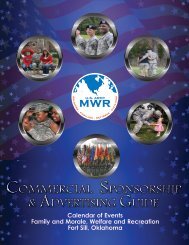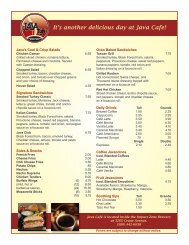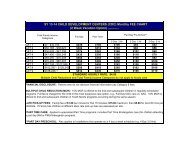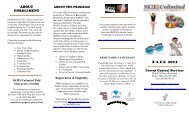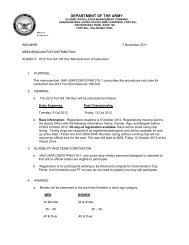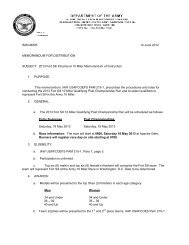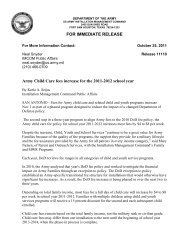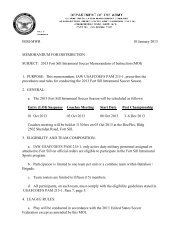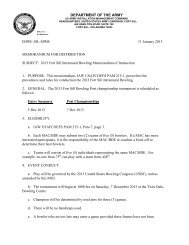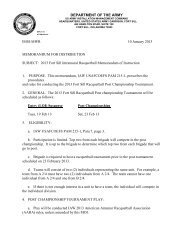Preparing and Managing Correspondence - Fort Sill MWR
Preparing and Managing Correspondence - Fort Sill MWR
Preparing and Managing Correspondence - Fort Sill MWR
You also want an ePaper? Increase the reach of your titles
YUMPU automatically turns print PDFs into web optimized ePapers that Google loves.
individuals outside the department or agency when a personal tone is appropriate, for official personal correspondence<br />
by military <strong>and</strong> civilian personnel, <strong>and</strong> for letters of welcome, appreciation, commendation, <strong>and</strong> condolence.<br />
3–3. Response phrases<br />
Do not use phrases like The Secretary has requested that I reply; The Secretary desires that I reply; or On (or In)<br />
behalf of the (name) unless the Secretary of the Army has specifically directed such a phrase.<br />
3–4. Abbreviations<br />
See paragraph 1–16.<br />
3–5. Appropriate replies <strong>and</strong> responses<br />
Use a letter to reply to other letters unless the originator requests otherwise. Forward a letter (for example, a letter of<br />
appreciation) through proper channels by attaching the letter to a brief memor<strong>and</strong>um.<br />
3–6. General rules<br />
a. Paper. The st<strong>and</strong>ard paper size for a letter is 8 1 ⁄2 by 11 inches.<br />
b. Original pages. Use computer-generated letterhead for the first page <strong>and</strong> use plain white paper for all continuing<br />
pages.<br />
c. Copies. Prepare only the number of copies needed. See paragraph 1–23 for more information on record, copy<br />
furnished, <strong>and</strong> reading file copies.<br />
d. Margins. Adjust the margins on the page, centering the body of the letter as if it were going to be placed in a<br />
picture frame. Generally, allow left <strong>and</strong> right margins of 1 inch. Do not justify right margins. When preparing two or<br />
more pages, leave at least a 1-inch margin at the bottom of the page.<br />
e. Addressing. See appendix D for proper addressing of letters.<br />
f. Point of contact. Use the last paragraph of a letter to provide point of contact. See paragraph 1–25.<br />
3–7. Format<br />
The letter consists of three major parts: the heading, the body (text), <strong>and</strong> the closing. Each part <strong>and</strong> its sub-elements are<br />
discussed in detail in the following paragraphs <strong>and</strong> in figures 3–1 through 3–4.<br />
a. Heading. The heading consists of five elements: the date, the Reply to Attention Of line, the subject line when<br />
used, the address, <strong>and</strong> the salutation. (See fig 3–1.)<br />
(1) Date. The date will be centered two lines below the last line of the letterhead. The date will be expressed in<br />
civilian style (for example, January 4, 2000).<br />
(2) Reply to Attention Of.<br />
(a) Office symbols rarely have any meaning <strong>and</strong> appear awkward to civilian recipients of a letter. Do not use them.<br />
It is better to use an underst<strong>and</strong>able phrase or title, such as Comptroller, Directorate of Training, or Director, Futures<br />
<strong>and</strong> Concepts (see fig 3–3), if it does not appear awkward (see para 3–7a(2)(c) for exception). If a more specific return<br />
address is required, it may be included in the text of the letter.<br />
(b) Begin office titles on the second line below the seal, starting at the left margin. If the letterhead address contains<br />
more than three lines, thereby bringing it near the bottom of the seal, type the date as usual two lines below the last<br />
line of the letterhead address.<br />
(c) Do not use office titles on the originals of correspondence prepared for signature by the Secretary of the Army.<br />
(d) There is no set number of lines between the Reply to Attention Of line <strong>and</strong> the first line of the address. Try to<br />
frame the letter on the page. Five lines is the general rule when the letter is two or more pages.<br />
(3) Addresses.<br />
(a) Do not use abbreviations in the address. The only exceptions to this rule are the abbreviations DC, US, PO Box,<br />
Mr., Mrs., Ms., Dr., Jr., Sr., 2nd., II, III, Ret., <strong>and</strong> the points of the compass (NE, NW, SE, <strong>and</strong> SW) <strong>and</strong> authorized<br />
State abbreviations.<br />
(b) There is no set number of lines between the Reply to Attention Of line <strong>and</strong> the address. Evenly space the letter<br />
on the page.<br />
(4) Salutation. Type the salutation on the second line below the last line of the address. (See app D.)<br />
b. Body (text).<br />
(1) Type the first line of the body of the letter on the second line below the salutation.<br />
(2) Indent as shown in figure 3–1.<br />
(3) Leave at least a l-inch margin at the bottom of multiple page letters.<br />
(4) If more than one page is needed (see fig 3–2), type a minimum of two lines on the continued page. Center the<br />
page number 1 inch from the top edge of the paper, typing a dash on each side of the page number.<br />
(5) Start the first line of the text on the fifth line below the number of the page, keeping the margins the same as<br />
those of the preceding page(s).<br />
AR 25–50 • 3 June 2002<br />
31




